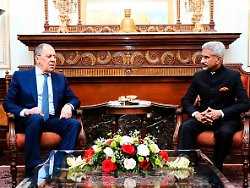Transactions in rupees and rubles
India wants to increase trade with Russia
April 2, 2022, 8:35 p.m
India does not follow the sanctions of the West. Instead, the country announces that it will increasingly buy goods from Russia. The Russian foreign minister is pleased. During his visit to New Delhi, Lavrov stressed the friendship between the two countries.
Russian Foreign Minister Sergei Lavrov was visibly satisfied after his visit to India. “We are friends,” he said during a performance with fellow singer Subrahmanyam Jaishankar in New Delhi. Then he added: “We are ready to supply any goods that India wishes to buy.” After his visit to China, Lavrov visited India this week, a country that is already one of the largest buyers of Russian raw materials. In view of the EU’s announcement that it would bid farewell to coal, oil and gas supplies from Russia as quickly as possible, Moscow is currently looking specifically for alternatives in Asia. In addition to India, the G20 country Indonesia had already signaled an interest in buying Russian oil.
India – after China the most populous country on earth – is of particular importance for Russia. The world’s largest democracy has not joined Western sanctions over the Russian invasion of Ukraine, but is pursuing a largely neutral course. While New Delhi has called for an immediate ceasefire in Ukraine, it has declined to explicitly condemn Moscow’s actions. The country has abstained from voting on several UN resolutions on the war.
US President Joe Biden had therefore criticized the Indian course as “shaky”. Because at the same time the country belongs to a so-called “quad” group with the USA, Japan and Australia because of the fears of China. But as much as they like working together with the USA against China, the Indian government is not interested in the conflict in distant Europe. Now, much to the chagrin of Europeans and Americans, there are indications that India could become one of the beneficiaries of the Western conflict with Russia, thereby supporting the government in Moscow.
So far, Russia is India’s main supplier of defense supplies, but the combined annual trade between the two countries is still small. It has averaged only about $9 billion over the past few years, mostly fertilizer and some oil. For comparison, India’s bilateral trade with China amounts to more than $100 billion a year. But given the sharp discount on Russian crude since the attack on Ukraine, India has now bought at least 13 million barrels, compared with almost 16 million barrels imported from Russia for all of last year.
“National interests first”
The government in New Delhi rejects criticism from the West. “I would put my country’s national interests first and I would put my energy security first,” Finance Minister Nirmala Sitharaman told CNBC-TV18, referring to cheap Russian oil. “Why shouldn’t I buy it? I need it for my people.” India is also considering doubling its imports of Russian coking coal for steelmaking, India’s steel minister said on Sunday. India also recently signed a deal to buy 45,000 tons of Russian sunflower oil for April – to replace failed supplies from Ukraine. “India will import more items from Russia overall, especially if there is a discount,” said a senior Indian government official.
The country could thus provide Russia with much-needed foreign exchange and serves as an example for Russian President Vladimir Putin as to why he assumes that he can withstand Western sanctions. India is also circumventing financial sanctions against Russia, which include excluding a number of Russian banks from the Swift settlement system. The New Delhi government is now trying to set up a rupee-ruble trading system. This could progress the decoupling of the world’s most populous countries from transactions in euros and dollars.
Lavrov agrees: “It is quite clear that more and more transactions are being processed through this system in national currencies, bypassing the dollar, euro and other currencies,” he said. Both countries could use a rupee-ruble mechanism to trade in oil, military equipment and other goods.
Source: ntv.de, Aftab Ahmed and Krishna N. Das, rts
